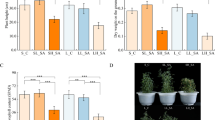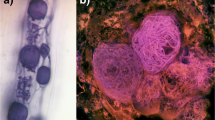Abstract
Elevated night temperature, one of the main climate warming scenarios, can have profound effects on plant growth and metabolism. However, little attention has been paid to the potential role of mycorrhizal associations in plant responses to night warming, although it is well known that symbiotic fungi can protect host plants against various environmental stresses. In the present study, physiological traits of Medicago truncatula L. in association with the arbuscular mycorrhizal (AM) fungus Rhizophagus irregularis were investigated under simulated night warming. A constant increase in night temperature of 1.53 °C significantly reduced plant shoot and root biomass, flower and seed number, leaf sugar concentration, and shoot Zn and root P concentrations. However, the AM association essentially mitigated these negative effects of night warming by improving plant growth, especially through increased root biomass, root to shoot ratio, and shoot Zn and root P concentrations. A significant interaction was observed between R. irregularis inoculation and night warming in influencing both root sucrose concentration and expression of sucrose synthase (SusS) genes, suggesting that AM symbiosis and increased night temperature jointly regulated plant sugar metabolism. Night warming stimulated AM fungal colonization but did not influence arbuscule abundance, symbiosis-related plant or fungal gene expression, or growth of extraradical mycelium, indicating little effect of night warming on the development or functioning of AM symbiosis. These findings highlight the importance of mycorrhizal symbiosis in assisting plant resilience to climate warming.





Similar content being viewed by others
References
Alward RD, Detling JK, Milchunas DG (1999) Grassland vegetation changes and nocturnal global warming. Science 283:229–231
Augé RM (2001) Water relations, drought and vesicular-arbuscular mycorrhizal symbiosis. Mycorrhiza 11:361–365
Azcón-Aguilar C, Padilla IG, Encina CL et al (1996) Arbuscular mycorrhizal inoculation enhances plant growth and changes root system morphology in micropropagated Annona cherimola Mill. Agronomie 16(10):647–652
Bai WM, Xia JY, Wan SQ, Zhang WH, Li LH (2012) Day and night warming have different effect on root lifespan. Biogeosciences 9:375–384
Baier MC, Keck M, Gödde V, Niehaus K, Küster H et al (2010) Knockdown of the symbiotic sucrose synthase MtSucS1 affects arbuscule maturation and maintenance in mycorrhizal roots of Medicago truncatula. Plant Physiol 152:1000–1014
Bond-Lamberty B, Thomson A (2010) Temperature-associated increases in the global soil respiration record. Nature 464:579–582
Cakmak I, Yilmaz A, Kalayci M, Ekiz H, Torun B et al (1996) Zinc deficiency as a critical problem in wheat production in Central Anatolia. Plant Soil 180:165–172
Campos-Soriano L, García-Garrido JM, Segundo BS (2010) Activation of basal defense mechanisms of rice plants by Glomus intraradices does not affect the arbuscular mycorrhizal symbiosis. New Phytol 188:597–614
Cheesman AW, Winter K (2013) Elevated night-time temperatures increase growth in seedlings of two tropical pioneer tree species. New Phytol 197:1185–1192
Clark DA, Piper SC, Keeling CD, Clark DB (2003) Tropical rain forest tree growth and atmospheric carbon dynamics linked to interannual temperature variation during 1984–2000. Proc Natl Acad Sci U S A 100:5852–5857
Farrar JF, Jones DL (2000) The control of carbon acquisition by roots. New Phytol 147:43–53
Frantz JM, Cometti NN, Bugbee B (2004) Night temperature has a minimal effect on respiration and growth in rapidly growing plants. Ann Bot 94:155–166
Grant RF, Kimball BA, Conley MM, White JW, Wall GW et al (2011) Controlled warming effects on wheat growth and yield: field measurements and modeling. Agron J 103:1742–1754
Hawkes CV, Hartley IP, Ineson P, Fitter AH (2008) Soil temperature affects carbon allocation within arbuscular mycorrhizal networks and carbon transport from plant to fungus. Glob Chang Biol 14:1181–1190
Hedhly A, Hormaza JI, Herrero M (2009) Global warming and sexual plant reproduction. Trends Plant Sci 14:30–36
Heinemeyer A, Ineson P, Ostle N, Fitter AH (2006) Respiration of the external mycelium in the arbuscular mycorrhizal symbiosis shows strong dependence on recent photosynthates and acclimation to temperature. New Phytol 171:159–170
Helber N, Wippel K, Sauer N, Schaarschmidt S, Hause B et al (2011) A versatile monosaccharide transporter that operates in the arbuscular mycorrhizal fungus Glomus sp. is crucial for the symbiotic relationship with plants. Plant Cell 23:3812–3823
Hohnjec N, Perlick AM, Pühler A, Küster H (2003) The Medicago truncatula sucrose synthase gene MtSucS1 is activated both in the infected region of root nodules and in the cortex of roots colonized by arbuscular mycorrhizal fungi. Mol Plant Microbe Interact 16:903–915
Hood TM, Mills HA (1994) Root-zone temperature affects nutrient uptake and growth of snapdragon. J Plant Nutr 17:279–291
Hu Y, Rillig MC, Xiang D, Hao Z, Chen B (2013) Changes of AM fungal abundance along environmental gradients in the arid and semi-arid grasslands of northern China. PLoS One 8:e57593
Huber SC, Akazawa T (1986) A novel sucrose synthase pathway for sucrose degradation in cultured sycamore cells. Plant Physiol 81:1008–1013
Isayenkov S, Fester T, Hause B (2004) Rapid determination of fungal colonization and arbuscule formation in roots of Medicago truncatula using real-time (RT) PCR. J Plant Physiol 161(12):1379–1383
Javot H, Penmetsa RV, Terzaghi N et al (2007) A Medicago truncatula phosphate transporter indispensable for the arbuscular mycorrhizal symbiosis. Proc Natl Acad Sci U S A 104(5):1720–1725
Karasawa T, Hodge A, Fitter AH (2012) Growth, respiration and nutrient acquisition by the arbuscular mycorrhizal fungus Glomus mosseae and its host plant Plantago lanceolata in cooled soil. Plant Cell Environ 35:819–828
Kaschuk G, Kuyper TW, Leffelaar PA, Hungria M, Giller KE (2009) Are the rates of photosynthesis stimulated by the carbon sink strength of rhizobial and arbuscular mycorrhizal symbioses? Soil Biol Biochem 41:1233–1244
Kimball BA (2005) Theory and performance of an infrared heater for ecosystem warming. Glob Chang Biol 11(11):2041–2056
Lehmann A, Veresoglou SD, Leifheit EF, Rillig MC (2014) Arbuscular mycorrhizal influence on zinc nutrition in crop plants-A meta-analysis. Soil Biol Biochem 69:123–131
Li T, Hu YJ, Hao ZP, Li H, Wang YS, Chen BD (2013) First cloning and characterization of two functional aquaporin genes from an arbuscular mycorrhizal fungus Glomus intraradices. New Phytol 197:617–630
Liu J, Blaylock LA, Endre G et al (2003) Transcript profiling coupled with spatial expression analyses reveals genes involved in distinct developmental stages of an arbuscular mycorrhizal symbiosis. Plant Cell 15(9):2106–2123
Luo Y (2007) Terrestrial carbon-cycle feedback to climate warming. Ann Rev Ecol Evol Syst 38:683–712
Martin CA, Stutz JC (2004) Interactive effects of temperature and arbuscular mycorrhizal fungi on growth, P uptake and root respiration of Capsicum annuum L. Mycorrhiza 14:241–244
McDonald GK, Paulsen GM (1997) High temperature effects on photosynthesis and water relations of grain legumes. Plant Soil 196(1):47–58
Pachauri RK, Reisinger A (2007) Climate Change 2007: Synthesis report. Contribution of working groups I, II and III to the fourth assessment report of the intergovernmental panel on climate change, Intergovernmental Panel on Climate Change. Cambridge University Press, New York
Pandey N, Pathak GC, Sharma CP (2006) Zinc is critically required for pollen function and fertilisation in lentil. J Trace Elem Med Biol 20:89–96
Peng S, Huang J, Sheehy JE, Laza RC, Visperas RM et al (2004) Rice yields decline with higher night temperature from global warming. Proc Natl Acad Sci U S A 101:9971–9975
Pfaffl MW (2001) A new mathematical model for relative quantification in real-time RT-PCR. Nucleic Acids Res 29:45–45
Phillips JM, Hayman DS (1970) Improved procedures for clearing roots and staining parasitic and vesicular-arbuscular mycorrhizal fungi for rapid assessment of infection. Trans Br Mycol Soc 55:158–161
Pozo MJ, Azcòn-Aguilar C (2007) Unraveling mycorrhiza-induced resistance. Curr Opin Plant Biol 10:393–398
Price MV, Waser NM (1998) Effects of experimental warming on plant reproductive phenology in a subalpine meadow. Ecology 79:1261–1271
Rillig MC, Wright SF, Shaw MR, Field CB (2002) Artificial climate warming positively affects arbuscular mycorrhizae but decreases soil aggregate water stability in an annual grassland. Oikos 97:52–58
Root TL, Price JT, Hall KR, Schneider SH, Rosenzweig C et al (2003) Fingerprints of global warming on wild animals and plants. Nature 421:57–60
Sharma PN, Chatterjee C, Agarwala SC, Sharma CP (1990) Zinc deficiency and pollen fertility in maize (Zea mays). Plant Soil 124:221–225
Smith SE, Bowen GD (1979) Soil temperature, mycorrhizal infection and nodulation of Medicago truncatula and Trifolium subterraneum. Soil Biol Biochem 11(5):469–473
Smith SE, Read DJ (2008) Mycorrhizal symbiosis. Academic press, London
Sturm A, Tang GQ (1999) The sucrose-cleaving enzymes of plants are crucial for development, growth and carbon partitioning. Trends Plant Sci 4(10):401–407
Tennant D (1975) A test of a modified line intersect method of estimating root length. J Ecol 63:995–1001
Tindall JA, Mills HA, Radcliffe DE (1990) The effect of root zone temperature on nutrient uptake of tomato. J Plant Nutr 13:939–956
Tommerup IC (1983) Spore dormancy in vesicular-arbuscular mycorrhizal fungi. Trans Br Mycol Soc 81:37–45
Trouvelot A, Kough JL, Gianinazzi-Pearson V (1986) Mesure du taux de mycorhization VA d'un système radiculaire. Recherche de méthodes d'estimation ayant une signification fonctionnelle. In: Gianinazzi-Pearson V, Gianinazzi S (eds) physiologie et génétique. 1er Séminaire Dijon, INRA, Paris. pp 217–221
Turnbull MH, Murthy R, Griffin KL (2002) The relative impacts of daytime and night-time warming on photosynthetic capacity in Populus deltoides. Plant Cell Environ 25:1729–1737
Wan S, Xia J, Liu W, Niu S (2009) Photosynthetic overcompensation under nocturnal warming enhances grassland carbon sequestration. Ecology 90:2700–2710
Zhang N, Xia J, Yu X, Ma K, Wan S (2011) Soil microbial community changes and their linkages with ecosystem carbon exchange under asymmetrically diurnal warming. Soil Biol Biochem 43:2053–2059
Acknowledgments
The study was financially supported by Chinese Academy of Sciences (KZCX2-YW-BR-17; XDB15030100) and National Natural Science Foundation of China (41071178, 41371264 and 31070476).
Author information
Authors and Affiliations
Corresponding author
Rights and permissions
About this article
Cite this article
Hu, Y., Wu, S., Sun, Y. et al. Arbuscular mycorrhizal symbiosis can mitigate the negative effects of night warming on physiological traits of Medicago truncatula L. Mycorrhiza 25, 131–142 (2015). https://doi.org/10.1007/s00572-014-0595-2
Received:
Accepted:
Published:
Issue Date:
DOI: https://doi.org/10.1007/s00572-014-0595-2




